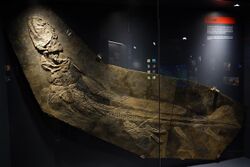Biology:Lebachacanthus
| Lebachacanthus | |
|---|---|

| |
| An illustration of Lebachacanthus | |

| |
| A Lebachacanthus senckenbergianus specimen housed in a collection from the Urzeitmeer-Museum | |
| Scientific classification | |
| Domain: | Eukaryota |
| Kingdom: | Animalia |
| Phylum: | Chordata |
| Class: | Chondrichthyes |
| Subclass: | Elasmobranchii |
| Order: | †Xenacanthida |
| Family: | †Diplodoselachidae |
| Genus: | †Lebachacanthus Soler-Gijon, 1997 |
| Species: | †L. senckenbergianus
|
| Binomial name | |
| †Lebachacanthus senckenbergianus Soler-Gijon, 1997
| |
Lebachacanthus is a genus of extinct xenacanth known from the late Carboniferous-Early Permian of Europe.[1] During the late Paleozoic, xenacanths were the apex predators of freshwater ecosystems, preying on small amphibians.[2]
Paleobiology
Lebachacanthus patrolled both fresh and marine waters, possibly preying on larvae of the temnospondyli and acanthodians.[2] The genus displays sexually dimorphic features; females had longer fin spines than males. Histological and biometric analyses of the spines of specimens provides information on the development and age at death of the fish and the environmental conditions in which they lived.[3]
Description
Like most other xenacanthids, this genus possessed an array of spines arising from the dorsal fins.[3] It grew up to 3 metres (9.8 ft).[3] The genus is often confused with the similar genus Orthacanthus; the two genera belong to entirely separate families.[4] The teeth of this fish were multi-cusped, with the central cusp flanked by two sharp accessory "tines" on which its prey would be impaled and trapped, in preparation for being swallowed whole.[5] It had an abundance of pectoral fins, two next to the head, two in the middle, one near the end, and one under the caudal fin.
References
- ↑ Ivanov, Alexander (30 August 2005). "Early Permian chondrichthyans of the Middle and South Urals". Revista Brasileira de Paleontologia 8 (2): 127–138. doi:10.4072/rbp.2005.2.05. ISSN 1519-7530. http://dx.doi.org/10.4072/rbp.2005.2.05.
- ↑ 2.0 2.1 Kriwet, J.; Witzmann, F.; Klug, S.; Heidtke, U. H. (2007). "First direct evidence of a vertebrate three-level trophic chain in the fossil record". Proceedings. Biological Sciences 275 (1631): 181–186. doi:10.1098/rspb.2007.1170. PMID 17971323.
- ↑ 3.0 3.1 3.2 Beck, Kimberly; Soler-Gijon, Rodrigo; Carlucci, Jesse; Willis, Raymond (2014). "Morphology and histology of dorsal spines of the xenacanthid shark Orthacanthus platypternus from the Lower Permian of Texas, USA: Palaeobiological and palaeoenvironmental implications". Acta Palaeontologica Polonica. doi:10.4202/app.00126.2014. https://bioone.org/journals/acta-palaeontologica-polonica/volume-61/issue-1/app.00126.2014/Morphology-and-Histology-of-Dorsal-Spines-of-the-Xenacanthid-Shark/10.4202/app.00126.2014.pdf.
- ↑ Soler-Gijón, Rodrigo (December 2000). "Phylogenetic relationships of Lebachacanthidae [Soler-Gijón 1997] (Xenacanthiformes; Elasmobranchii)". PalZ 74 (3): 363–377. doi:10.1007/BF02988107.
- ↑ Hotton, Nicholas (1952). "Jaws and Teeth of American Xenacanth Sharks". Journal of Paleontology 26 (3): 489–500. https://www.jstor.org/stable/1299956.
Further reading
- Long, John A.; Young, Gavin C. (May 1995). "Sharks from the Middle-Late Devonian Aztec Siltstone, southern Victoria Land, Antarctica". Records of the Western Australian Museum 17: 287–308. https://museum.wa.gov.au/sites/default/files/SHARKS%20FROM%20THE%20MIDDLE-LATE%20DEVONIAN%20AZTEC%20SILSTONE,%20SOUTHERN%20VICTORIA%20LAND,%20ANTARCTICA.pdf. Retrieved 10 March 2022.
Wikidata ☰ {{{from}}} entry
 |

